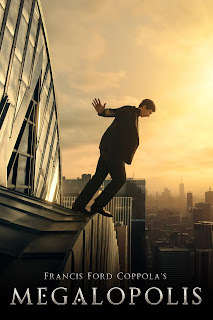Megalopolis | review by Rafe McGregor
Self-reflexive or self-indulgent?

Likemany Anglophone readers of my generation, I suppose, I first came across‘megalopolis’ in one of the many Judge Dredd comics published in 2000 ADmagazine during the 1980s. The word was used to describe Dredd’s beat, ‘Mega-CityOne’, a gargantuan city covering the Eastern Seaboard of North America from Miamito Quebec City. I assumed both ‘megalopolis’ and ‘mega-city’ were sciencefiction inventions, but the Oxford English Dictionary taught meotherwise. ‘Megalopolis’ was used as far back as 1828, as a synonym for‘metropolis’, and is now more commonly used to describe the contiguous built-uparea formed when metropolises expand into one another (beginning with LosAngeles in the 1960s). ‘Megacity’ came much later, in 1967, and identifies ametropolis with more than 5 million residents (beginning with the Dallas-FortWorth conurbation). In case anyone is interested, the biggest megacity in theworld is currently Tokyo, with a population of approximately 39 million, andthe biggest megacity in the US, New York, with 19 million. The setting ofFrancis Ford Coppola’s Megalopolis is ‘New Rome’, an alternative, futureNew York, and the title also alludes to megalon, a material or mineral withmagical properties that can regenerate and restore both cities and the peoplethat live in them. When the narrative opens, protagonist Cesar Catalina (playedby Adam Driver) has recently been awarded a Nobel Prize for his creation of megalon.
I firstheard about Megalopolis long before it was released in September 2024 –not because of any especially effective marketing strategy, but because of the conditionsof its conception and production. Coppola began thinking about it in the late 1970sand began work on it in the early 1980s. The original idea seems to have beensomething like a cinematic Ulysses (1922), James Joyce’s monumental reimaginingof Homer’s Odyssey in 1904 Dublin (which is, in my opinion, the greatestnovel ever published and ever likely to be published). Joyce’s source materialwas the most celebrated story ever told in the Western canon (or the second mostcelebrated, if you prefer the Iliad, which most scholars don’t), butCoppola’s was a curious choice. He had already tried something similar with ApocalypseNow (1979), a magnificent reimagining of Joseph Conrad’s brilliant novella,Heart of Darkness (1899), in South-East Asia during the Vietnam War. Megalopoliswould, in contrast to both Apocalypse Now and Ulysses, reimaginea historical event, the Catilinarian conspiracy in the Roman Republic of 63BCE, in a faintly futuristic New York. The conspiracy was an attempted coupd’état by Catilina, aimed at seizing power from consuls Cicero and Hybrida,and never passed into popular culture. (Though I consider myself an amateurhistorian, I had to look it up). Perhaps more problematic, where the monstrouscomplexity of Ulysses is to at least some extent clarified by knowledgeof the Odyssey, knowledge of the historical conspiracy actuallycomplicates the film: the fictional Catalina is called ‘Cesar’, but (Julius)Caesar (who is absent from the film) played a historical part; the attemptedinsurrection is by Clodio Pulcher (played by Shia LaBoeuf) whereas ClodiusPulcher opposed the coup; Hybrida and Cato have no fictionalcounterparts and there are several major characters without historicalcounterparts. Notwithstanding, Megalopolis is a reimagining, of FritzLang’s Metropolis (1927), one of the first feature length sciencefiction films and one of the greatest films ever screened.
Bythe turn of the century, Coppola had decided he would fund his ‘passion’ (orperhaps ‘vanity’) project himself and began shooting cityscapes of New York. Atthe turn of the next decade, he started writing the script. Eight years later,on the day before his 80th birthday, he announced that he’d finishedthe script, raised $120 million for a budget, and was ready to start interviewingactors. Filming began in 2022 and rumours of Coppola’s erratic behaviour soonspread, followed by allegations that he was under the influence of cannabis forlengthy periods, had sexually assaulted extras, and exceeded the budget by $16 million.It’s difficult to know how much of this to take seriously, but when I readabout it, the whole enterprise reminded me of Frank Pavich’s Jodorowsky’sDune (2013), a documentary about Alejandro Jodorowsky’s unsuccessfulattempt to film Frank Herbert’s novel, Dune (1965), in the 1970s. Jodorowsky’sventure was hubristic to the point of insanity, ethically dubious, and doomedto failure, although the documentary acquired both critical acclaim and a cultfollowing. Immediately after watching Megalopolis, I discovered thatCoppola commissioned director Mike Figgis to make a documentary of the makingof his film, which was released this month as Megadoc (2025). I wonder ifCoppola’s motivation for the documentary was vanity or finances? Probably a bitof both.
Megalopolis begins with truly masterful exposition: we are shown almost everything we need to know about what will follow in the first 12 minutes (of 133 from opening to closing credits). One is simultaneously struck by the film’s idiosyncratic yet impressive style, a unique combination of filmed theatre, tasteful CGI, breathtaking cinematography, and beautiful mise-en-scène. Very quickly, we learn that Catalina has a utopian vision for New Rome at odds with Mayor Franklyn Cicero (played by Giancarlo Esposito) and the ability to stop time, which works on everyone except for Cicero’s wayward daughter, Julia (played by Nathalie Emmanuel). The plot is briskly set in motion when Catalina’s ambitious girlfriend, television presenter Wow Platinum (played by Aubrey Plaza), realises he is still in love with his dead wife and seduces his aged uncle, Hamilton Crassus III (played by Jon Voight), the wealthiest man in New Rome. Meanwhile, Crassus’ son, Pulcher, a spoiled wastrel jealous of the success of everyone around him, is desperate to make a name for himself. The ingredients are all simmering in the pot and our appetites whetted for making a meal of what follows. Shortly over half an hour in, the stakes are established as the question of whether or not Catalina will succeed in realising his architectural and humanitarian dream and all of Cicero, Wow, Pulcher, and Catalina’s self-destructive guilt about his wife’s death framed as antagonists or obstacles. Later, Wow Crassus and Pulcher will emerge as the villains of the piece. Later still, they join forces and become an apparently unstoppable dystopian threat that raises the stakes and heightens the tension in an altogether satisfying way. So, what goes wrong?I noted that the reimagined history was confusing. The pseudo-Roman settingconstitutes part of Coppola’s distinctive style, which is pleasing on both theeye and the ear, but otherwise pointless. The same is true of the very limitedadvanced technology that seems to have been responsible for the film beingclassed as science fiction. While megalon is the means by which Catalina intendsto realise his vision, that means could just as easily have been an imaginedbut mundane mineral or a fictional but plausible construction method.Similarly, the sole purpose of Catalina’s ability to stop time as far as theplot is concerned is to show that there is a genuine connection between him andJulia once they fall in love. If I appear overly critical of the film’s retrofuturism,the categorisation as science fiction in particular brings with it certainexpectations, for example that the film will to at least some extent be aboutadvanced technology or about the psychological or political impact (or both) ofthat technology. Futuristic megalon is as incidental as Catalina’s superpowerand, like the Roman retrospection, serves a stylistic function, providingCoppola with the opportunity to present some (once again) aestheticallypleasing CGI. To remain with the plot a little longer, the story is very much thatof Catalina’s ambition and the film a vehicle for Driver as Catalina. In thatpart, he either lacks the charisma or does not bring enough of it to thisperformance to engage and enthral the audience for the quantity and quality ofhis screen time. I found myself much more interested in Julia and Wow, watchingthe narrative as a tug of war between two powerful women with Catalinarelegated to the role of the rope. As a final criticism of the plot, once all islost for Catalina and Julia, the tables are turned by Crassus in a scene thatis absolutely ridiculous. I think it’s meant to be amusing rather thandramatic, a deliberate parody of itself, but it’s neither tense nor funny andfalls flat.
IfMegalopolis is not about the Catilinarian conspiracy and/or itscontemporary counterparts or the impact of advanced technology such as megalon,then what is it about? I mentioned Metropolis earlier and while thereare several references to Lang’s masterpiece (and no doubt some that I missed),Megalopolis does not share its themes. Aside from a few superficialmentions of immigrants being unwelcome and some gratuitous police brutality,Coppola fails to offer a perspective on social justice and does not represent classconflict or even class consciousness. With politics, technology, and justice strippedaway, there isn’t very much left. A theme that emerges with admirable speed inthe expert exposition is some elaboration of the relationship between time andcreation, the latter in the sense of artistic creativity. As the narrativeprogresses, a link is established with first utopian desire and then romanticlove, all bound up within a temporal horizon. Early in the second half of thefilm, Catalina tells Julia, ‘I can’t create anything without you next to me’ andone is inevitably reminded of Coppola’s wife of six decades, Eleanor, to whomthe film is dedicated and who died shortly before its release. The tyranny oftime, the inspiration and perspiration of creation, dreams of a better way oflife, loving as a way of living…Megalopolis is a film about itself,about the trials and tribulations of its own creation. Coppola has fictionalisedhis creative process from conception to production, creating an almost entirelyself-reflexive epic. And while that doesn’t make it a poor film, it does meanthat it doesn’t have very much to say to its audience, not much more than we couldfind in Megadoc anyway.
Thecritical response was initially described as ‘polarised’, but reviews have beenlargely negative, the only notable exception being Sight and Soundmagazine, who placed Megalopolis 17th on their list of thebest 50 films of 2024. To me, ‘polarised’ suggests something broad in scope andrich in depth, a work of boldness and ambition that will either flop or berecognised as a work of genius but could never be mediocre. I just don’t seethis kind of greatness in it. There are plenty of highlights – Coppola’s style,the slick start, Emmanuel and Plaza’s performances – but more lowlights and Megalopolisis neither a magnum opus nor anadir. The film has 45% on the Tomatometer, which is not unfair, though I do wonderif critics would have been more generous if they didn’t know that it was theproduct of 50 years of work. Unfortunately for Coppola, it was also a majorcommercial failure, only recouping £14.3 million at the box office and costinghim $75.5 million by May 2025. At the time of writing, Coppola is 86, whichsuggests that this is his last film. While it’s a shame to see a career endthis way, we should not forget that he is the genius who brought us all three Godfathers,Apocalypse Now, The Outsiders (1983), and Bram Stoker’sDracula (1992), among many others. I hope he doesn’t forget either.**



